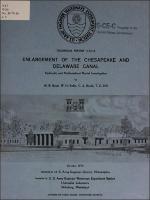Please use this identifier to cite or link to this item:
https://hdl.handle.net/11681/13187| Title: | Enlargement of the Chesapeake and Delaware Canal : hydraulic and mathematical model investigation |
| Authors: | United States. Army. Corps of Engineers. Philadelphia District Boyd, M. B. (Marden B.) Bobb, William H. Huval, C. J. Hill, Thomas C. |
| Keywords: | Chesapeake and Delaware Canal Hydraulic models Mathematical models Numerical models Sea level canals Environmental impact Inland navigation Canals Waterways Flow |
| Publisher: | Hydraulics Laboratory (U.S.) Engineer Research and Development Center (U.S.) |
| Series/Report no.: | Technical report (U.S. Army Engineer Waterways Experiment Station) ; H-73-16. |
| Description: | Technical Report Abstract: Enlargement of the sea-level C&D Canal connecting Chesapeake Bay and Delaware River from 27 by 250 ft to 35 by 450 ft, undertaken in 1954, was essentially complete by 1970 except for about a 2-mile reach at the Delaware River end. Concern about effects of the enlargement on the environmental and biological systems led to the decision to leave the unimproved reach intact, pending completion of extensive environmental studies. The study program included field measurements, physical and mathematical model studies, and ecological studies. This report is concerned with the model studies. The existing Delaware River model was extended to include the 27-by 250-ft C&D Canal and Elk River and the propagation of tides and currents in the addition was verified. Tides, currents, salinities, and discharges were then measured for various head differentials across the canal. The canal was first enlarged to existing conditions (35 by 450 ft, except for the unimproved reach at the Delaware end) and subsequently to project conditions and comparative measurements were made. The critical phenomenon affecting flow in the canal is head differential (∆H) across the canal produced by Chesapeake Bay tides at the western end and Delaware River tides at the eastern end. The canal is a very dynamic system and can experience large ∆H changes daily. Net flow is toward the lower tide level and enlargement from 27 by 250ft to August 1972 conditions caused net flow to be increased by a factor of about 4.8 and completion of enlargement will cause additional increases. Dye dispersion tests were made for 27 by 250 ft and completed canal conditions and a mean ∆H. An existing numerical model based on the one-dimensional unsteady flow equations was used for initial studies concerning net flow changes due to the enlargement. A relatively simple numerical model was developed, tested against known analytical solutions, and applied to show expected salinity changes after enlargement and a reversed salinity gradient near the eastern end of the canal in agreement with field and physical model measurements. NOTE: This file is large. Allow your browser several minutes to download the file. |
| Rights: | Approved for public release; distribution is unlimited. |
| URI: | http://hdl.handle.net/11681/13187 |
| Appears in Collections: | Technical Report |
Files in This Item:
| File | Description | Size | Format | |
|---|---|---|---|---|
| TR-H-73-16.pdf | 32.02 MB | Adobe PDF |  View/Open |